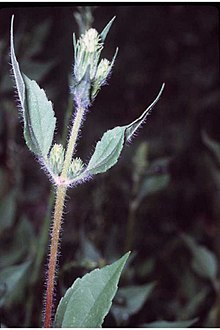Sumpweed
| Iva annua | |
|---|---|
 |
|
| Scientific classification | |
| Kingdom: | Plantae |
| (unranked): | Angiosperms |
| (unranked): | Eudicots |
| (unranked): | Asterids |
| Order: | Asterales |
| Family: | Asteraceae |
| Genus: | Iva |
| Species: | I. annua |
| Binomial name | |
|
Iva annua L. 1753 |
|
| Synonyms | |
|
|
Iva annua, the annual marsh elder or sumpweed, is a North American herbaceous annual plant in the sunflower family. It is native to northeastern Mexico (Tamaulipas) and to the central and southern United States, primarily the Great Plains and Mississippi Valley as far north as North Dakota. There are some populations in the eastern US, but these appear to represent introductions.
Iva annua is an annual herb up to 150 cm (5 feet) tall. The plant produces many small flower heads in a narrow, elongated, spike-like array, each head with 11-17 disc florets but no ray florets.
Iva annua was cultivated by Native Americans over 4,000 years ago in the central and eastern United States and specifically the indigenous peoples of the Kansas City Hopewell culture in present-day Missouri and Illinois, for its edible seed. The edible parts contain 32 percent protein and 45 percent oil.
However, like its relative ragweed, sumpweed possesses many objectionable qualities which include being a severe potential allergen and a disagreeable odor. Probably for these reasons it was abandoned once more pleasant alternatives (such as maize) were available, and by the time Europeans arrived in the Americas, had long disappeared as a crop.
...
Wikipedia
